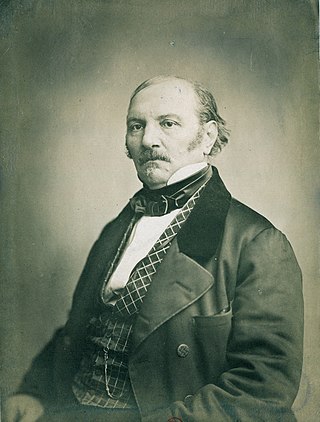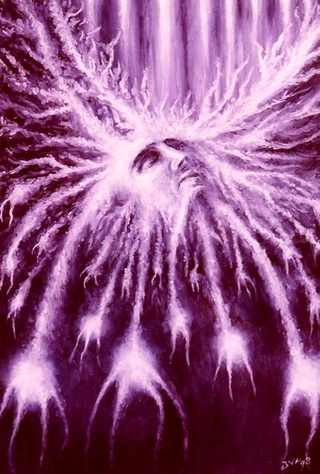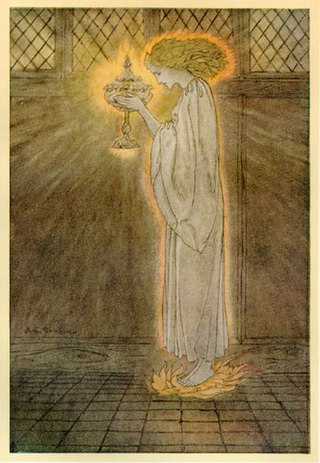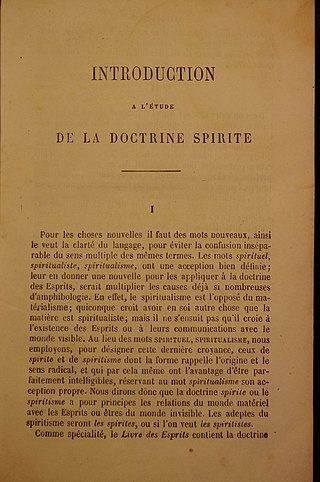
Chakras are various focal points used in a variety of ancient meditation practices, collectively denominated as Tantra, or the esoteric or inner traditions of Hinduism and Buddhism.

Allan Kardec is the pen name of the French educator, translator, and author Hippolyte Léon Denizard Rivail. He is the author of the five books known as the Spiritist Codification, and the founder of Spiritism.

Spiritism, spiritist doctrine, Kardecism or Kardecist spiritism is a reincarnationist doctrine established in France in the mid-19th century by the author and educator Allan Kardec. It explains, from a Christian perspective, the cycle by which a spirit supposedly returns to material existence after the death of the old body in which it dwelled, as well as the evolution it undergoes during this process. The concept also interacts with philosophical and scientific conceptions of the relationship between the physical and the moral. Kardecism emerged as a new religious movement branched from the spiritualistic field, the notions and practices associated with spiritual communication disseminated throughout North America and Europe since the 1850s.

Spiritualism was a social religious movement in the nineteenth century, according to which an individual's awareness persists after death and may be contacted by the living. The afterlife, or the "spirit world", is seen by spiritualists not as a static place, but as one in which spirits continue to evolve. These two beliefs—that contact with spirits is possible, and that spirits are more advanced than humans—lead spiritualists to the belief that spirits are capable of providing useful insight regarding moral and ethical issues, as well as about the nature of God. Some spiritualists will speak of a concept which they refer to as "spirit guides"—specific spirits, often contacted, who are relied upon for spiritual guidance. Emanuel Swedenborg has some claim to be the father of Spiritualism. Spiritism, a branch of spiritualism developed by Allan Kardec and today practiced mostly in Continental Europe and Latin America, especially in Brazil, emphasizes reincarnation.

A subtle body is a "quasi material" aspect of the human body, being neither solely physical nor solely spiritual, according to various esoteric, occult, and mystical teachings. This contrasts with the mind–body dualism that has dominated Western thought. The subtle body is important in the Taoism of China and Dharmic religions such as Hinduism, Buddhism, and Jainism, mainly in the branches which focus on tantra and yoga, where it is known as the Sūkṣma-śarīra. However, while mostly associated with Asian cultures, non-dualistic approaches to the mind and body are found in many parts of the world.

The astral body is a subtle body posited by many philosophers, intermediate between the intelligent soul and the mental body, composed of a subtle material. In many recensions the concept ultimately derives from the philosophy of Plato though the same or similar ideas have existed all over the world well before Plato's time: it is related to an astral plane, which consists of the planetary heavens of astrology. The term was adopted by nineteenth-century Theosophists and neo-Rosicrucians.
In esoteric cosmology, a plane is conceived as a subtle state, level, or region of reality, each plane corresponding to some type, kind, or category of being.
In philosophy and religion, spirit is the vital principle or animating essence within humans or, in some views, all living things. Although views of spirit vary between different belief systems, when spirit is contrasted with the soul, the former is often seen as a basic natural force, principle or substance, whereas the latter is used to described the organized structure of an individual being's consciousness, in humans including their personality. Spirit as a substance may also be contrasted with matter, where it is usually seen as more subtle, an idea put forth for example in the Principia Mathematica.

Integral yoga, sometimes also called supramental yoga, is the yoga-based philosophy and practice of Sri Aurobindo and The Mother. Central to Integral yoga is the idea that Spirit manifests itself in a process of involution, meanwhile forgetting its origins. The reverse process of evolution is driven toward a complete manifestation of spirit.

In neo-Theosophy, the etheric body, ether-body, or æther body is the subtle body propounded in esoteric philosophies as the first or lowest layer in the human energy field or aura. The etheric body is said to be in immediate contact with the physical body and to sustain it and connect it with "higher" bodies. It is also said to consist of a finer substance, more pure and composed of smaller particles, than the ordinary matter of the physical plane.

Mediumship is the practice of purportedly mediating communication between familiar spirits or spirits of the dead and living human beings. Practitioners are known as "mediums" or "spirit mediums". There are different types of mediumship or spirit channelling, including séance tables, trance, and ouija.

The Spirits' Book is part of the Spiritist Codification, and is regarded as one of the five fundamental works on Spiritism. It was published by the French educator Hippolyte Léon Denizard Rivail, under the pen name of Allan Kardec on April 18, 1857. It was the first and remains the most important Spiritist book, because it addresses in first hand all questions developed subsequently by Allan Kardec.

The Book on Mediums or Mediums and Evokers' Handbook, is a book by Allan Kardec published in 1861, second of the five Fundamental Works of Spiritism — the philosophy Kardec had been publishing — being the tome in which the experimental and investigative features of the doctrine were presented, explained and taught.

The Genesis, Miracles and Premonition According to Spiritism was the last book published (1868) by Allan Kardec, just before his death. It tries to reconcile science and religion and develops a series of important scientific and philosophical topics, relating them to Spiritism.
Obsession, also known as spirit obsession, is a technical term within the Spiritist belief and practice defined by the author Allan Kardec as the interference of a subjugating spirit with a weaker spirit. Although the term most commonly refers to the negative influence of the spirit of an evil deceased person on the mind or spirit of a living person, obsession can occur in either direction.

Ectoplasm is a term used in spiritualism to denote a substance or spiritual energy "exteriorized" by physical mediums. It was coined in 1894 by psychical researcher Charles Richet. Although the term is widespread in popular culture, there is no scientific evidence that ectoplasm exists and many purported examples were exposed as hoaxes fashioned from cheesecloth, gauze or other natural substances.

Léon Denis was a notable French spiritist philosopher, and, with Gabriel Delanne and Camille Flammarion, one of the principal exponents of spiritism after the death of Allan Kardec. Denis lectured throughout Europe at international conferences of spiritism and spiritualism, promoting the idea of survival of the soul after death and the implications of this for human relations. He is known as the apostle of French spiritism.
Spiritualism is a metaphysical belief that the world is made up of at least two fundamental substances, matter and spirit. This very broad metaphysical distinction is further developed into many and various forms by the inclusion of details about what spiritual entities exist such as a soul, the afterlife, spirits of the dead, deities and mediums; as well as details about the nature of the relationship between spirit and matter. It may also refer to the philosophy, doctrine, or religion pertaining to a spiritual aspect of existence.

Denominated basic works of Spiritism, also referred to as Codificação Espírita, are five books published by the French educator Hippolyte Léon Denizard Rivail under the pseudonym Allan Kardec, between 1857 and 1868. The Basic Works are part of the Fundamental Works of Spiritist Doctrine, which comprise 11 publications by Allan Kardec.

For Spiritism, Jesus is the most perfect model of a human being that God has offered to serve as a guide. In this sense, Allan Kardec states that, "for humankind, Jesus constitutes the type of moral perfection that Humanity can aspire to on Earth. God offers him to us as the most perfect model, and the doctrine he taught is the purest expression of the Lord's law because, being the most spiritually pure of all those who have appeared on Earth, he was animated by the Divine Spirit".












